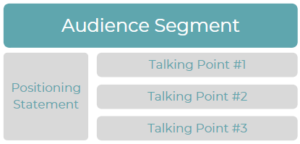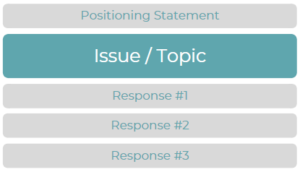What is a Messaging Platform and Why Do You Need One?

December 3, 2020
By Curley & Pynn
Alongside the sharp company logo and witty tagline – and created with the same thoughtful planning and communication channels in mind – the messaging platform is a key foundational piece of any business toolbox. It serves to house the official talking points of an organization and consistently train company spokespersons at all levels to accurately reflect a brand’s image. The business messaging platform should contain background information and official company responses to anticipated questions from media, stakeholders and other relevant publics.
Using corporate messaging to convey meaningful information about the brand is important, not only for consistency, but for repetition. When calling to mind the most trusted global companies, you can’t ignore that what we (the general public) know about these brands is what we’ve been told over and over again by company-driven marketing, advertising and media content – and all of that starts with messaging.
When might it be helpful to create a messaging platform?
Are you in the process of starting a new company, rebranding your existing organization or launching a new product or service? Change can be scary, but it doesn’t have to be. Especially in this day and age, organizations must adapt to an ever-changing environment in order to reach their audiences with clear and impactful messages.
So, what is the enemy of adaptability? Lack of preparation and purpose. With proper messaging channels, companies can define a path based on predetermined guideposts established by communications professionals and other corporate leaders.
Messaging is not just important during times of great change. Perhaps your company needs to communicate a shift in organizational strategy, prepare in the event of a crisis or simply interact with the public to convey a succinct and consistent message. Having a platform from which to draw talking points can often bridge the gap between failure and success.
Why is it important to have one?
A messaging platform is intended for internal use to align employees and other stakeholders with brand messages. Using a single document for training purposes ensures consistency, regardless of the messenger (customer service representative, media spokesperson, team manager, etc.) or the context. When armed with a messaging platform, brand ambassadors can and will revisit the learned messages when giving a presentation, developing marketing collateral, networking at a professional event, chatting with neighbors or speaking with media (even, as President Dan Ward, APR, CPRC, reminds us, via Zoom).
Ultimately, the desired outcome is positive brand positioning and reputation management.
The information contained in a messaging platform can also serve as the foundation for a business plan – including a company’s mission, vision and values – and will certainly inform crisis communication strategies as needed.
How do you collect the information?
What is important to your organization? What do you wish to convey? This is the time to refer to your mission and your goals, such as what you desire your target publics to know about you or the actions you’d like them to take. It is important that new organizations developing a platform for the first time consider the competitive landscape, analyzing the messages of similar brands, how/what trade media writes about those brands and the reputation of the industry at large.
Now that you have the information, how do you format it?
Since message development is often driven by public relations, marketing or public affairs teams responsible for a company’s engagement with external stakeholders, we typically see companies prepare a standard “Q&A” document. Those trained with this format attempt to remember responses when asked similar questions in media interviews, which can be a tricky endeavor. While a standard Q&A or FAQ document may be helpful when thinking through tough questions in advance, it doesn’t prepare your spokespeople to respond to questions that are not on the list – and what do you do when that happens? If you have a messaging platform to turn to, this feat becomes much easier. In our view, it’s best to start with the “A” before even thinking about the “Q.” Thinking through what you want to communicate is more important than guessing what you may be asked.
In a messaging platform, messages can be segmented by audience for easy recall. In this format, the first of three to five talking points (often called a “positioning statement”) is the most important and lays the foundation for the messages that follow. This statement can be shared across all audience categories. The subsequent talking points under each category should appeal to that specific audience, highlighting the value proposition and problem-solving nature of a product or service for that segment.

A platform can also be organized by issue, as with Curley & Pynn’s proprietary Message Matrix®. This two-in-one messaging and media training program starts by segmenting topics or features, identifying a positioning statement, building several messages around those issues and teaching spokespersons to bridge to the most relevant response when questioned by the media or other important publics.

Again, this format can often contribute to the development of other corporate communications, planning and training materials.
There are several other ways a messaging platform can be formatted, tailored to fit the audience and only limited by the creativity of an organization’s communications team. Take Tulane University’s Messaging Map, for example.
It’s done. Now what? How do you incorporate it into everything you do?
It is important to maintain one central place where the “final” or most up-to-date version of your messaging platform lives. One person or team should be responsible for housing the information and distributing it as necessary. Access is key to keeping all parties informed and updated.
The platform can then be used in onboarding and media training, as well as for reference by marketing and customer service representatives who communicate most often with external stakeholders. C-Suite-level executives and their assistants should have an updated copy at all times.
Whether you are just establishing your business or revamping your existing communications plan, consider the must-have messaging platform your guide to delivering strong content to the appropriate audiences at the right time. You’ll be glad you did. Contact us for additional counsel and support in crafting PR messages and getting your team media ready.




